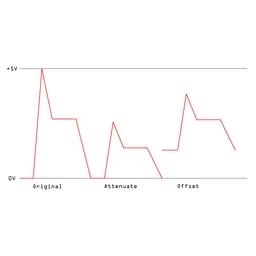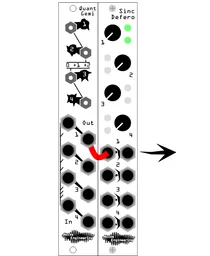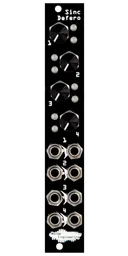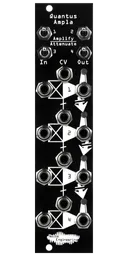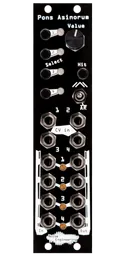Welcome back to Getting Started, the series where we explore the fundamental types of Eurorack modules and discuss what they do, how to use them, and how they fit into a system. And of course, it wouldn’t be a Noise Engineering blog without some wackiness, so at the end of each post we’ll discuss a more advanced/abstract/unusual technique for each type of module for you more experienced patchers out there. Today, we’ll be discussing envelope generators, VCAs, and attenuators. These are some of the most common types of modules, and you’ll probably use them in almost every patch in one way or another.
What is an envelope?
If we want to understand envelope generators, it helps to understand what envelopes are. Then we can think about why we might want to generate one, what to do with it, and how to use it. While envelope generators are a synthesis concept, all sounds have envelopes (including frog calls, says Kris, who used to do a lot of her analyses just by looking at the envelope of the calls on her recordings!). In modular, you’re often shaping your own envelope, so knowing what the heck the envelope is is a first step to understanding if/why you need (or want) to do it.
In the last post in this series, we talked about oscillators in modular, and the fact that they continually oscillate. That’s cool for making drones, but if you want to create any other sort of sound that ever stops, we need a way to “tell” the patchto stop making sound. We can do that in part with envelope generators, and in part with VCAs, which we’ll talk about next! We can do that in part, with the modular tools in this post.
A sound’s envelope is its overall shape. If you’re not used to looking at sounds, there are many ways to do it, but the simplest is the waveform, which looks like this:

The waveform is just a representation of the sound over time. We generally use it to plot the amplitude (height, which is related to the volume) and how that changes.
If we draw a contour over the general shape of the waveform, that’s the volume envelope:

The envelope is the contour drawn in green over the waveform. This is a very simple Attack-Release envelope.
The envelope is really important to how we hear the sound: it is part of what makes a piano sound like a piano, a violin sound like a violin, and an executioner treefrog sound like an executioner treefrog.
Generating envelopes with an envelope generator
Now that we know what an envelope is, let’s make one. To do this, we’ll use an envelope generator, which is one of those nicely named categories of modules that explains exactly what it does. There are lots of ways to use envelopes, but today we’ll talk about the most basic one: in a patch to control the dynamics of a sound (like in the waveform graph) by modulating a VCA.
Envelope generators output control voltage (CV) in the form of envelopes and are themselves controlled by gates and triggers. A gate is an on/off message that can come from, for instance, a keyboard: when you press down a key, the gate would go high, and when you release the key, the gate would go low. Gates can also come from sequencers, if you don’t feel like playing the keys, and a few other places in a modular system.

Envelope generators are generally named after the stages of the envelope. The most common type of envelope generator is the ADSR. ADSR stands for Attack, Decay, Sustain, Release envelope, or ADSR, naming the different stages of the envelope.
Unlike on a traditional instrument like a piano, where the envelope of a sound is defined by physics, the length of each stage of the envelope generator is generally set by the user with controls on a module. Our Gate is our on/off signal, so when it turns the ADSR envelope on (a “high” gate), the A stage starts. Once it reaches its peak, it Decays for the specified time, but only to the Sustain level specified by the user. The envelope then hangs out at that level until the gate turns off, and then the envelope Releases and the envelope falls to 0. How long that release lasts is, you guessed it, set by the Release parameter.
ADSR isn’t the only type of envelope: there are tons of other envelope types, generally described by their stages. The simplest type is the Decay envelope, which, when triggered, simply rises to a peak instantly and falls to 0 in an amount of time set by the Decay value.
The most complicated types have even more stages, like the DAHDSR (delay, attack, hold, decay, sustain, release), or other features like looping.
Of course, this being modular, we don’t just have to use envelopes to control the dynamics of things: pretty much anything can be controlled by an envelope -- after all, it’s just a CV! We can use envelopes to change the timbres of sounds by, for instance, modulating a filter cutoff or a wavefolder (more on those in future posts!). Or, we can use them as key sound design tools; if you want a sneak-peek into some more advanced synthesis topics, we used envelopes to modulate the pitch of oscillators in this post about creating kick drums.
Envelopes are often used to control the dynamics of an oscillator, but to do that, we need to team up with another type of module: the VCA.
What is a VCA?
VCAs, or Voltage-Controlled Amplifiers, control the level of signals based on input CV. We can use this to shape the sound of our oscillator and to “tell” it to turn off and on. For instance, if an oscillator is patched through a VCA, and it’s controlled by an envelope generator, it will make the oscillator silent while the envelope is low. As soon as that envelope starts to rise, the oscillator will get louder, and its volume will follow the shape of the envelope. There’s nothing saying you can’t use other types of CV (including gates!) to control your VCA, but it may be a bit less musical in the classical sense. The takeaway here is that a VCA changes the volume of a signal based on the CV that you feed into it.
Of course, that’s not the only use for a VCA: they can be used to control the levels of other CV signals, create effects like tremolo, and a host of other creative things.
Attenuators?
Another common and useful utility in Eurorack is the attenuator.
While a bit of an unusual choice to include in a post about VCAs and envelopes, attenuators are kind of like VCAs without voltage control -- you put a signal in, and set its level with a knob or slider.
There are so many different places that you could use an attenuator that it would be impossible to list them all. One common use is, you guessed it, on envelopes: if you want to modulate a parameter with an envelope, but it sounds too extreme when you patch it up, run the envelope through an attenuator to limit its range and tame the modulation to something more musical.
What are some common patches with these modules?
As I mentioned before, all of these modules are quite common and have a huge number of uses. However, there are some staple patches that make use of envelopes and VCAs (and, often, attenuators), so here are a couple of quick examples to put these modules in context.
The basic
We’ve talked about how to use these things, but if you’re more visual, here’s the breakdown: an oscillator is patched to a VCA. An envelope generator is patched to the CV input on the VCA and triggered with a gate source. And voilà, you have an oscillator that stops and starts.
But this is the most basic use case, and we can spruce it up in lots of ways. Read on.

A subtractive voice
One of the most famous patches is the subtractive voice: an oscillator is run through a filter to modify its sound, then that filter’s output runs through a VCA. Two envelopes are used: one to control the VCA and create the dynamics for the whole patch, and the other envelope is run through an attenuator and modulates the filter’s cutoff to add some interest to the patch.
This architecture can be found in countless synthesizers, from the Model D to the MS-20 to digital synthesizers like Massive.

A simple hi-hat
This one is even simpler than the previous: a white noise oscillator is run through a highpass filter, then through a VCA. The VCA is controlled by a simple decay envelope, and that creates a very basic hi-hat sound.

Looking for modules?
Here are just a few modules that can perform some of the functions we've been chatting about. There are always lots of choices in modular!
Noise Engineering Quantus Ampla: A quad VCA that can process audio and CV.
Noise Engineering Sinc Defero: A quad attenuator and mult.
Doepfer A-140 Envelope Generator: A traditional ADSR envelope generator.
For the experienced patcher: filter your envelopes
Got a DC-coupled filter in your system?
Filters and slews are basically the same thing. And you may be thinking, “slewing an envelope won’t do much at all!” And in most cases, you’d be right.
However, there’s one thing filters have that most slews don’t: resonance.
Add a touch of resonance and tweak the filter cutoff, and you’ll start to get some really interesting movement out of your envelopes. They won’t quite level out at the sustain stage, and on release you’ll get a bit more up-and-down: it’s kind of like adding an LFO to your envelope in a really unusual way. Fun stuff!

